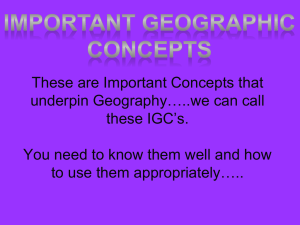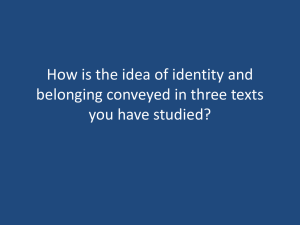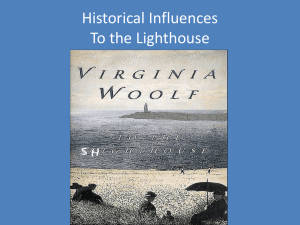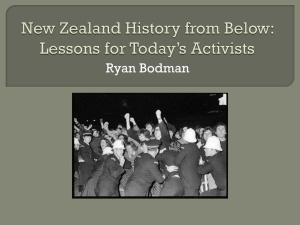PowerPoint slideshow
advertisement
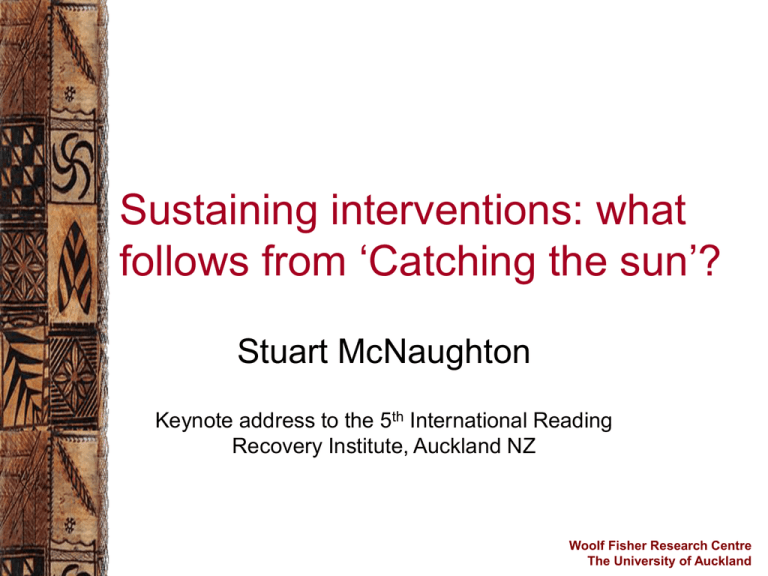
Sustaining interventions: what follows from ‘Catching the sun’? Stuart McNaughton Keynote address to the 5th International Reading Recovery Institute, Auckland NZ Woolf Fisher Research Centre The University of Auckland Woolf Fisher Research Centre The University of Auckland Woolf Fisher Research Centre The University of Auckland Maui’s nets The sun was permanently tamed by the net of twine, cord and ropes. – great evidence In the current analysis – great sustainability Woolf Fisher Research Centre The University of Auckland But educational nets and their permanence? ‘Sustainability may be the central challenge of bringing reforms to scale. Schools that successfully implement reforms find it difficult to sustain them in the face of competing priorities, changing demands and teacher and administrator turn over…’ (Coburn 2003, p.6) Woolf Fisher Research Centre The University of Auckland Some conditions (from Coburn) (1) ‘Externally developed school reforms may be especially vulnerable to this problem because implementation typically involves a short-term influx of resources, professional development, and other forms of assistance to facilitate implementation that dissipates over time as external developers turn their attention to other sites… (2) teachers with a deep understanding of the pedagogical principles of reform are better able to respond to new demands and changing contexts in ways that are consistent with the underlying principles of reform, thus sustaining and, at times, deepening reform over time’ (p.6). Woolf Fisher Research Centre The University of Auckland The evidence is not good for sustaining reforms in general For example the experiences of Head Start and Follow Through Or: Olson (2003) argues reforms based our science of psychology have been spectacularly ineffective; some may even have had negative effects (eg child centered reforms) (Olson’s argument: most reforms miss the role of school as cultural organisations) Woolf Fisher Research Centre The University of Auckland Types of sustainability: ( more contributions from RR?) Strong evidence for sustainability: – with new cohorts of children – with new cohorts of teachers – maintaining programme integrity over time – across cultural, social, linguistic and educational contexts Interesting issues – balance problems Woolf Fisher Research Centre The University of Auckland #5: Developmentally sustained What happens after an intervention? – near and far development? Near transfer for RR managed in 2 ways – entry level and strategies for engaging – joint planning to optimise transition Woolf Fisher Research Centre The University of Auckland Our ‘far’ problem Subsequent instructional conditions set channels for development When the channels are constructed for ‘low’ gradients this creates a more general issue for teaching and learning This is a major challenge for sustaining early interventions in the context of cultural and linguistically diverse schools (decile 1 schools) Woolf Fisher Research Centre The University of Auckland Education Indicators Framework for the Early Childhood and Schooling Sectors- Ministry of Education / Alton-Lee (2004) Educational Research & Development Families & Communities About 4065% of variance in outcomes Outcomes 16- 60% of variance in outcomes Quality Teaching Educators, Teacher Education & Research Infrastructure 0 to 20.9% of variance in outcomes Physical Resources & Organisation Leadership & Governance Learner Participation & Involvement Woolf Fisher Research Centre The University of Auckland The situation: (Lai et. al. 2003) Disparities in reading comprehension for Māori and Pasifika children – international comparisons (high average, long tail) – national comparisons (low decile / Maori and Pasifika students, low achievement) Clusters of schools are aware Existing effective instructional programme in the early years (Phillips et. al. 2004): seen as a school challenge Woolf Fisher Research Centre The University of Auckland Participants Seven decile 1 schools, Initiative Leaders, Woolf Fisher Research Centre, Ministry of Education 60 teachers and their classrooms 1900 students in years 4-9 – equal proportions of males and females – four main ethnic groups (Samoan, Tongan, Māori and Cook Island) – about half with home language other than English – 5 bilingual classes Woolf Fisher Research Centre The University of Auckland General hypothesis: capability within an expanded ‘community’ A research-practice collaboration (1) baseline phase:exploring current teaching and learning patterns (a design parallel to RR’s ‘roaming’?) – area-wide analysis of achievement and classroom data – individual school analysis of data – whole staff sessions – projects to test out teaching ideas – descriptions (interpreted within design) Woolf Fisher Research Centre The University of Auckland General profile of reading comprehension Percentage of students 35 30 25 20 PAT 15 STAR 10 5 0 1 2 3 4 5 6 7 8 9 Stanine Woolf Fisher Research Centre The University of Auckland More importantly: patterns on reading assessments (eg..) Recall and inference equally ‘low’ Relatively ‘high’ on word recognition Paragraph comprehension most difficult: across year levels, groups (and mainstream / bilingual classrooms) Vocabulary range low Woolf Fisher Research Centre The University of Auckland Specific hypotheses (a): Decoding less likely to be the problem – subtest analyses – rates of completion on tests – more anecdotal evidence - running records Woolf Fisher Research Centre The University of Auckland Specific hypotheses (b) Teaching and Learning: Boost vocabulary – factual and inferential answers both low; ‘vocabulary range’ low on tests Develop checking & use of evidence – high prediction rates in class: prompting to check occurred 9 times in 16 hours of observations; low Cloze and errors Increase instructional density – rates of interactions per student low; access to texts low Incorporate cultural/linguistic resources for texts but bridge to unfamiliar texts With each focus make activities more explicit Woolf Fisher Research Centre The University of Auckland ‘error’ analysis from Cloze ‘All they did (could) afford was a tiny room in a shoe (cottage/house/shop) in a village by a river.’ ‘He grabbed frantically, and felt his head (hand(s)/finger(s)) closing around the branch of a tree.’ ‘Suddenly, round a sharp bend in the head (road/path/track), he fell again, missed his self (footing/step) and plunged over the ugly (cliff/rock) face.’ Woolf Fisher Research Centre The University of Auckland Boosting vocabulary Retune core activities (and interactions) such as reading to A set to detect and enjoy new words (both teachers and students) – eg ‘Word detectives’: • ‘Pronking’ • Genetically modified organism Planning topic / theme-based vocabulary Woolf Fisher Research Centre The University of Auckland Detecting & checking evidence Retune core activities (and interactions) such as guided reading / reciprocal teaching A set to use text evidence (both teachers and students) – for teachers analysis of interact ional features Close reading of assessment as activities to solve Woolf Fisher Research Centre The University of Auckland Close reading of Cloze test (paragraph comprehension) Instructions – “The stories below have some blank spaces, where words have been left out. Read the stories and write down the word that you think has been left out, one for each blank. Try to write one word in every space, even if you are not sure what it should be” (STAR, NZCER 2001) Woolf Fisher Research Centre The University of Auckland Instructional density Retune core activities – eg .. amount of time spent in explicit instruction prior to or outside of text reading For teachers a set to optimise rates of quality interaction per student – eg.. grouping for reading to A question of resources – eg.. electronic texts – the dictionary problem Woolf Fisher Research Centre The University of Auckland Creating bridges: familiar to unfamiliar Identifying complex thinking in everyday activities and potential parallels with classroom activities eg… – LOL (metalinguistic awareness) – Hip hop / rap (playing with texts: polysyllabification) – Church texts (complex vocabulary; move into interpretation) Note David’s point- yesterdays new text tomorrow’s prior knowledge Avoiding tendency to homogenise culture Woolf Fisher Research Centre The University of Auckland Everyday knowledge eg… Mareko with Deceptikonz rapping : ‘In the morning I woke up frozen and my arms are now broken If u look closer u will notice dat my shoulders floatin’ (from ‘Stop, drop and roll’ 2003) His raps might be compared with Jabberwocky (Lewis Carroll ‘Through the Looking Glass’ ) ‘Twas brillig, and the slithy toves Did gyre and gimble in the wabe:….. (Oxford University Press, 1971 134 – 136) Woolf Fisher Research Centre The University of Auckland So...sustainability – some components (a) teaching Teachers and developing expertise – knowledge and beliefs – actions / strategies (performance) – awareness (control and regulation) Notice the knowledge here: – theoretically rich – professionally rich – context rich (cultural and linguistic) Woolf Fisher Research Centre The University of Auckland Musical expertise: Deborah Wai Kapohe, Moana Woolf Fisher Research Centre The University of Auckland Sporting expertise: Carlos Spencer, Beatrice Faumuina Woolf Fisher Research Centre The University of Auckland (b) Professional learning Community (eg. Timperley 2003) Shared norms and values – eg all students can learn / teaching effects Focus on student learning – evidence-based Reflective dialogue Deprivatising practice Collaboration – use of evidence – checking practices Very like the properties of RR Woolf Fisher Research Centre The University of Auckland Distribution across all stanines Percentage of students 30 25 20 STAR beginning of year STAR end of year 15 10 5 0 1 2 3 4 5 6 7 8 9 Stanine Woolf Fisher Research Centre The University of Auckland Developmental sustainabilityReading Recovery? Beliefs, knowledge, practices of ‘near’ and ‘far’ teachers? Specific practices to build on RR after year 1 and 2? The question of teaching and learning comprehension, especially for culturally and linguistically diverse students? Our local and global village Woolf Fisher Research Centre The University of Auckland Woolf Fisher Research Centre The University of Auckland



